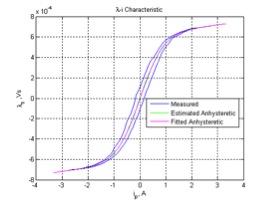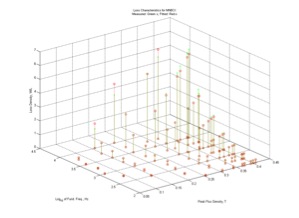Characterization of Magnetic Materials
The design of electromagnetic and electromechanical devices is ultimately governed by material properties and limitations. Of particular interest at Purdue are the magnetic properties of materials. Appropriately characterizing magnetic materials leads to the ability to be more aggressive in the design process thereby leading to smaller and/or less lossy components.
One of the most important properties of magnetic materials is the anhysteretic B-H characteristic, which describes how the flux density would be related to the applied field in the absence of magnetic hysteresis. This property of magnetic materials directly governs the size of a large variety of components including power transformers, power inductors, and rotating electric machinery. Although this characterization procedure has been thought of as well understood [1], Purdue faculty have pointed out substantial errors in the standard characterization procedure and shown how these errors can be mitigated [2]. These errors include failure to address field variation in the material and localized saturation. Purdue’s Power Magnetic Laboratory is now used to characterize materials by a variety of material manufacturers and component vendors.

λ-i Characteristic Used to Find B-H Characteristic
The dynamic behavior of magnetic materials is also of great interest, as these behavior govern the loss in the magnetic material, which is of concern both because it is desired to be efficient and because the losses impact thermal constraints. Generally losses are represented using behavioral models such as the Steinmetz model and its numerous variants. Alternately, occasionally more physics based models such as the Jiles-Atherton or Praisach models are used. One aspect all of these models share is the need for the time-domain waveform for the fields throughout the material. When using evolutionary computing techniques where the losses in millions of designs need to be evaluated [3-4], modeling losses in this way can be computationally burdensome. To alleviate this, Purdue researcher have developed the field extrema loss model which allows losses to be determined solely from the minimum and maximum field values [5]. In addition, the method has proven itself to be more accurate than Steinmentz based models. Purdue continues to be actively engaged in characterizing individual materials, magnetic modeling, and finding methods to extract material parameters. Purdue’s Power Magnetics Laboratory is well suited to support this work.

Loss Density Versus Frequency and Flux Density
References
[1] J.L. Cale, S.D. Sudhoff, “An Improved Magnetic Characterization Method for Highly Permeable Materials,” IEEE Transactions on Magnetics. Vol. 42, Issue 8, August 2006
[2] IEEE Standard 393-1991
[3] J.Cale, S.D. Sudhoff, R.R. Chan, “Ferrimagnetic Inductor Design using Population-Based Design Algorithms,” IEEE Transactions on Magnetics. vol. 45, no. 2, pg(s) 726-734. February 2009.
[4] B.N. Cassimere, S.D. Sudhoff, “Population Based Design of Permanent Magnet Synchronous Machines,” IEEE Transactions on Energy Conversion, vol. 24, no. 2, pg(s) 347-357. June 2009
[5] J.L. Cale, S.D. Sudhoff, R.R. Chan, "A Field-Extrema Hysteresis Loss Model for High-Frequency Ferrimagnetic Materials," IEEE Transactions on Magnetics, vol. 44, no. 7, pg(s): 1728-1736, July 2008
